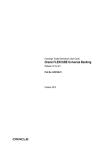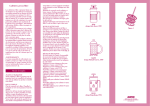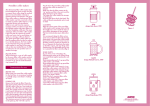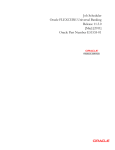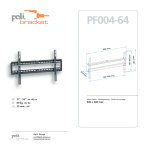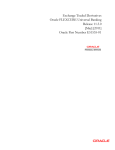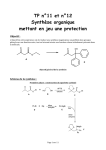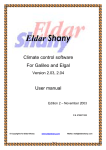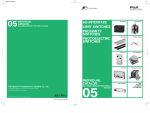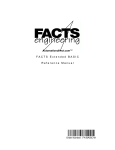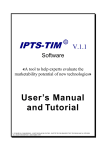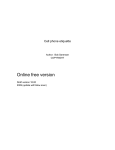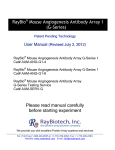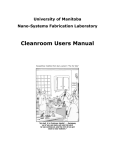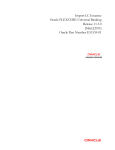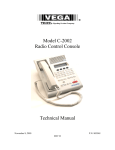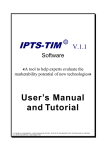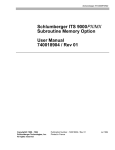Download Margin Maintenance User Manual
Transcript
Margin Maintenance Oracle FLEXCUBE Universal Banking Release 11.3.0 [May] [2011] Oracle Part Number E51535-01 Margin Maintenance Table of Contents 1. THE MARGIN MAINTENANCE SERVICE............................................................................................... 1-1 1.1 INTRODUCTION ........................................................................................................................................... 1-1 1.1.1 The features of the Margin Maintenance Sub-system ........................................................................ 1-1 1.1.2 Maintenance required for the sub-system.......................................................................................... 1-2 1.1.3 Who can create a Margin product? ................................................................................................... 1-3 1.2 CREATING A MARGIN PRODUCT ................................................................................................................. 1-3 1.2.1 Specifying your Preferences for the Margin product......................................................................... 1-4 1.2.2 Specifying Accounting Entries and Events......................................................................................... 1-5 1.2.3 Restricting Customers Categories ..................................................................................................... 1-7 1.2.4 Specifying the MIS Details for a Product .......................................................................................... 1-8 2. DEFINING A MARGIN SCHEME ............................................................................................................... 2-1 2.1 INTRODUCTION ........................................................................................................................................... 2-1 2.1.1 Features of the Margin Scheme Maintenance screen ........................................................................ 2-1 2.1.2 Specifying MIS details for a margin scheme...................................................................................... 2-2 2.1.3 Specifying the Settlement Instructions ............................................................................................... 2-2 3. PROCESSING MARGIN TRANSACTIONS............................................................................................... 3-1 3.1 INTRODUCTION ........................................................................................................................................... 3-1 3.1.1 Specifying the Settlement Instructions for a margin transaction ....................................................... 3-1 3.1.2 Viewing Accounting details ............................................................................................................... 3-2 3.1.3 Generating the Advices for an Event ................................................................................................. 3-2 4. SCREEN GLOSSARY .................................................................................................................................... 4-1 4.1 FUNCTION ID LIST...................................................................................................................................... 4-1 1. 1.1 The Margin Maintenance Service Introduction The Margin Maintenance sub-system is the channel through which money settlements arising due to the various events processed in the respective modules are routed. The sub-system also facilitates the netting of all settlements for an individual customer. 1.1.1 The features of the Margin Maintenance Sub-system The need for a Margin Tracking sub-system is explained using the following illustration: As a bank which deals in exchange traded derivatives you can either trade in the market on behalf of your bank or on behalf of your portfolio customers. When you are acting on behalf of your customer as per customer instructions to buy or sell contracts you are simply mediating between the Broker / Exchange / Clearing Member on the one hand and the Customer on the other. However, since you maintain separate portfolios for yourself and you need to buy and sell contracts on a regular basis, you will need to mediate with brokers on an on-going basis. Therefore, the Broker/Clearing Member/Exchange becomes the counterparty through whom you access the market whereas the Customer is the entity on behalf of whom your bank is transacting. When your customer places an order with your bank, you will in-turn route the order to the appropriate market participant. Consequently, you will impose margin requirements on your customer. However your bank is also bound by margin requirements stipulated by the counter party on the other side. These requirements need not be identical. To meet the margin requirements of your portfolio customers and brokers, you need to set-up separate schemes for Broker/Clearing Members and Portfolio Customers. For example, in your North Carolina branch of Chase Manhattan bank, you have maintained two customer portfolios PF003 and PF004 respectively. Each of these portfolios have been linked to the following schemes: Portfolio ID Scheme ID PF003 SMPC001 PF004 SMPC002 Another scheme SMBR004 is linked to the Broker ID - CITI. As per your customer instructions you open 120 long positions in the specified contract for PF003 and 100 long positions for PF004. Since the trade initiation is done through the broker CITI, the process necessitates margin settlement with the Broker as well as the portfolio customers. Therefore, while processing the margin settlement transaction with the Broker, you will use the scheme SMBR004, and specify the settlement amount for a total of the 220 long positions opened during the day. However, while processing the margin settlement transaction for your portfolio customers you will initiate two separate margin settlement transactions. One involving the scheme SMPC001 and the other one involving the scheme SMPC002. 1-1 The balance in the margin scheme can either be topped-up or refunded. As part of the EOD programs the system check for the margin balance in the customer schemes and generates a Margin Call advice if the margin balance is below the margin maintenance level. Since every scheme is associated with a currency, while defining margin schemes for a portfolio customer you can maintain as many schemes as the number of currencies. The linkage between the Margin Scheme and the Currency is done as part of the Portfolio Maintenance for customer portfolios. Similarly, the broker scheme-currency linkage is maintained through the Broker Scheme definition screen. 1.1.2 Maintenance required for the sub-system For the Margin Maintenance sub-system to function effectively, firstly you need to set up Margin Products in Oracle FLEXCUBE. Margin products basically provide the infrastructure for the maintenance of the various events, accounting entries and advices. You can choose to maintain margin products to cater to two types of customer categories: Your bank’s Brokers/Clearing Members/Clearing Houses – the definition and maintenance of Broker Margin products helps you to manage the margin requirements of your bank’s brokers. Your Portfolio Customers – you can use a Customer Margin product to handle the margin requirements of your bank’s portfolio customers After defining margin products you need to create Margin Schemes for individual customers. A margin scheme is a pool or balance that maintains a net receivable or payable position for a Broker or Portfolio Customer. The existing modules in Oracle FLEXCUBE interface with the Margin Maintenance sub-system using the Margin Scheme. It is because of the transactions involved in the various front-end modules that the Receivable/Payable balance in the scheme is built up. Apart from the various modules, a margin settlement, which is a transaction of the Margin Maintenance sub-system also affects the scheme pool balance. A data diagram of the Margin Maintenance sub-system illustrates its work-flow: Margin Product Broker / CM / PfPf-Customer Product Type Role to Head Event Accounting Margin Scheme Margin Settlement Transactions with PfPf-Customer / Broker Top Up / Reduction in Margin Total Receivable/Payable to the PfPf-Customer/Broker Tracking System Modules like ED will contribute to this Receivable / Payable pool. pool. The module will hand over the following details for a Receivable tracking. •Receivable / Payable •Amount •Customer / Broker 1-2 The maintenance of Margin Products and Schemes and the processing of Margin Settlements have been dealt with in detail in the sections detailed below. 1.1.3 Who can create a Margin product? A margin product is created in the Head Office branch of your bank. Any user in the head office, with the requisite rights, can create a product. 1.2 Creating a Margin Product You can capture information pertaining to a margin product through the ‘Margin Product Definition’ screen. You can invoke this screen by typing ‘MGDCPROD’ In the field at the top right corner of the Application Browser and clicking the adjoining arrow button. In this screen, you can enter the basic details of the product. They are: the product code and module a description of the product the product type a slogan for the product the group to which the product belongs the Start Date of the product the End Date of the product the remarks, if any Product Code You can identify a product that you maintain with a unique Product Code, and a brief description. In the Product Code field, you must assign the product a unique code (which is unique across all the modules of Oracle FLEXCUBE). This code helps in identifying the product. You can briefly describe a product that you create in the Description field. 1-3 The services that you offer in a module will be specific to the module. For example, a broker margin maintenance product is specific to the ETD (Margin) module. You can view the module in which you are creating a product in the Product Module field. Product Slogan You can enter a slogan for the product that you are creating. In the Slogan field enter a slogan that suitably announces the product to your brokers/portfolio customers depending on the product type you are maintaining. Product Group Grouping products according to the common features they share, helps you organize information relating to the services you provide. This helps you retrieve information easily. You can invoke a list of all the product groups that you have maintained in your bank. Choose the product group to which the product you are creating belongs. Start Date and End Date When you create a product, you must also specify a date from which it can be offered. You may also specify the date upto which you would like to offer the product. Enter these dates in the Start Date and End Date fields. You cannot offer a product beyond the specified end date. If you do not specify an end date for a product, you can offer it for an indefinite period. Remarks If you want to enter any remarks regarding the product, do so in the Remarks field. 1.2.1 Specifying your Preferences for the Margin product Indicating the values to be re-keyed during authorization In Oracle FLEXCUBE, all operations on a margin settlement record (input, amendment, modification, etc.) have to be authorized by a user other than the one who entered the details of the record. These operations have to be carried out before the end-of-day activities have begun. Authorization is a way of checking the entries made by a user. As part of specifying the preferences for a margin product, you can indicate that details of certain fields should be re-entered when a margin settlement record is invoked for authorization. This process is called re-key authorization. Re-key authorization is used as a cross-checking mechanism. During authorization, the complete details of the margin settlement record will be displayed only after the values to the re-key fields have been entered. To indicate that re-key authorization should be done for contracts involving the product check the Re-key Required box in this screen. You can specify any or all of the following as re-key fields: Scheme ID Scheme Event Settlement Amount If no re-key fields have been defined, the details of the margin transaction involving the product will be displayed immediately when the authorizer calls the specific record for authorization. The re-key option also serves as a means of ensuring the accuracy of inputs. You can specify the authorization re-key fields through the Margin Product Preferences screen. 1-4 1.2.2 Specifying Accounting Entries and Events Each product that you maintain in Oracle FLEXCUBE will impact specific accounting heads (GLs). Therefore while defining a product you have to identify all GLs specific to the product and indicate their roles individually. The different stages in the life cycle of a margin product are referred to as events. After identifying accounting roles and mapping them with account heads, you have to identify the various events that need to be associated with the margin product. Subsequently, you will also have to identify accounting entries, which have to be posted when individual events are triggered in Oracle FLEXCUBE. The mapping of accounting roles to respective account heads and the identification of life-cycle events at which they ought to be triggered automates the process of posting accounting entries. Example Scenario I Let us assume you are defining a margin product for Brokers with the product code - MGBR. As part of identifying and mapping accounting roles to appropriate account heads you would have to identify two GLs: 1. An amount Payable account. 2. An amount Receivable account. Your bank has maintained separate payable and receivable GL for Brokers. Consequently your entries in the respective fields would be as follows: Accounting Role Description Account Head Account Description BR_PAYABLE Broker Payable Account LI2000009 Suspense – Liability BR_RECEIVABLE Broker Receivable Account AS2100003 Suspense Asset Next, we have to identify and associate life-cycle events with the margin product. Event Description MREF Margin Refund MTOP Margin Top Up Now, we have to identify the accounting entry that has to be posted when each event is triggered in Oracle FLEXCUBE. Event Code – MREF Account Role Amount Tag Dr/Cr Indicator Transaction Code BR_SETTLEMENT MG_SETLM_AMT_MREF Debit MSC (Miscellaneous) BR_RECEIVABLE MG_SETLM_AMT_MREF Credit MSC (Miscellaneous) Advices The advice associated with this event is – Debit Advice. 1-5 Event Code - MTOP Account Role Amount Tag Dr/Cr Indicator Transaction Code BR_PAYABLE MG_SETLM_AMT_MTOP Debit MSC (Miscellaneous) BR_SETTLEMENT MG_SETLM_AMT_MTOP Credit MSC (Miscellaneous) Advices The advice associated with this event is – Credit Advice. The accounting entries maintained at the product level will be defaulted to all transactions associated with the product. As a result, each time you process a margin transaction involving this product, the system posts the accounting entries mapped at the product level. Scenario II Now, let us assume you are defining a margin product for Portfolio Customers. The Product Code that you assign to this product is - MGPF. As in the earlier case you will need to identify Accounting Roles and Events and map relevant Accounting Entries to the events. Your entries in the respective screens would be as follows: Role to Head Mapping screen Accounting Role Description Account Head Account Description PF_PAYABLE Portfolio Payable Account LI2000009 Suspense-Liability PF_RECEIVABLE Portfolio Receivable Account AS2100003 Suspense-Asset Next, you will identify and associate life-cycle events with the portfolio margin product. Event Description MTOP Margin Top Up MREF Margin Refund The accounting entries that need to be posted when each of these events are triggered will be as follows: Event Code - MTOP Account Role Amount Tag Dr/Cr Indicator Transaction Code PF_SETTLEMENT MG_SETLM_AMT_MTOP Debit MSC (Miscellaneous) PF_RECEIVABLE MG_SETLM_AMT_MTOP Credit MSC (Miscellaneous) Advices We will specify that a Debit Advice is to be generated whenever this event is triggered. 1-6 Event Code – MREF Account Role Amount Tag Dr/Cr Indicator Transaction Code PF_PAYABLE MG_SETLM_AMT_MREF Debit MSC (Miscellaneous) PF_SETTLEMENT MG_SETLM_AMT_MREF Credit MSC (Miscellaneous) Advices We will indicate that a Credit Advice is to be generated whenever this event is triggered. You can map accounting roles to specific account heads through the Product Accounting Role to Head definition screen. Identification of life-cycle events and association of appropriate accounting entries with each event has to be done through the Event-wise Accounting Entries and Advices definition screen. 1.2.3 Restricting Customers Categories Customers can be grouped according to the common characteristics that they share. For example, you can group your customers into: Banks Corporate Financial Institutions (excluding banks) Individuals While defining Margin products you can choose to restrict specific customer categories from using the margin product. Conversely, you also have the option of restricting specific customers within a product from using the product. For instance, let us assume that you have segregated the customers of your bank into the following categories: Portfolio Customers Brokers Industrialists Agriculturists You are defining a Broker type of margin product. Therefore you will maintain the Restriction Type as Allowed and move category Brokers to this column, thereby restricting the other three categories from using this product. When you disallow the other three customer categories from using the product, the system automatically displays the details of all customers classified under the restricted categories in the Customer Access column. You would like to allow the industrialist Mr. Amitabh Chowdhury to use this product. Choose from the option list and change the restriction status to Allowed. Specific customers and customer categories can be restricted through the Customer Categories Restriction screen. 1-7 1.2.4 Specifying the MIS Details for a Product You can define the Management Information System (MIS) details for the margin product that you are creating through the MIS Product details screen. Through the MIS product details screen you can link the product to transaction MIS codes. The transaction codes linked to the product are defaulted to the margin settlement transaction record. 1-8 2. 2.1 Defining a Margin Scheme Introduction A margin scheme broadly defines your counterparty’s (Portfolio Customer or Broker) margin requirements. It represents the arrangement that your Portfolio Customer has with your bank for a particular currency. In the case of Brokers, a scheme represents the arrangement that your bank has with the broker for a particular currency. Since a scheme is a pool of balance maintaining a net receivable or payable position for a Broker or a Portfolio Customer you can choose to liquidate the scheme either partially or wholly at any given point in time. Every scheme that you define is linked to a Margin product and a Customer. Consequently, each scheme is indicative of whether the relationship that the counterparty shares with your bank is that of a Portfolio Customer or a Broker / Clearing Member. The ‘Margin Scheme definition’ screen is available in the Oracle FLEXCUBE Browser under the Maintenance tab. 2.1.1 Features of the Margin Scheme Maintenance screen Linking a Margin Scheme to a product You should necessarily use a margin product that has already been created while capturing the details of a margin scheme. You can either choose to associate a Broker type or Customer Portfolio type of margin product depending on whether the scheme is meant for a portfolio customer or for a broker. For instance, let us assume that you are creating a margin scheme for Brokers of your bank for settling receivable/payable balances arising out of transactions processed in the Exchange Traded Derivatives module. In this case you will have to associate a Broker type of margin product with the scheme. To select a product, click on the option list positioned next to the Product field. After you associate a margin product with the scheme the system displays the Scheme Type as Portfolio Customer or Broker depending on the product type associated with the scheme. 2-1 The Reference Number and the Scheme ID Each time you maintain the details of a new scheme the system automatically assigns a unique Reference Number to the scheme. You have the option of modifying this reference number. The Scheme ID is also generated by the system. You will not be allowed to modify the Scheme ID since it is assigned by the system. Indicating the Scheme details As part of specifying the scheme details firstly you have to indicate the code of the customer for whom you are creating the particular scheme. After you indicate the Customer Code, you have to specify the currency in which the scheme is to be maintained. Click on the option list positioned next to the respective fields and select the Customer Code and Currency from the lists that get displayed. In addition to specifying the Customer Code and Currency you have to indicate the Rate Code and Rate Type that is to be associated with the currency. The different rates maintained in the Exchange Rates screen are identified by unique Rate Codes. The Rate Code identifies the corresponding rate maintained in the Exchange Rate table. Whenever a conversion is done this rate will be picked up and applied on the margin transaction associated with the scheme. Similarly, the Rate Type indicates whether the rate to be applied on the margin transaction is the Mid Rate or the Buy/Sell Rate. Specifying the Settlement details You have to indicate the default account that should be involved in the accounting entries for settling margin transactions in the particular scheme. The currency of the Settlement Account should be the same as that of the Scheme Currency After indicating the Settlement Account, you have to indicate the code of the branch to which the settlement account belongs. Specifying the Margin Level details You can indicate the minimum Initial and Maintenance margin amounts for the scheme that you are maintaining. 2.1.2 Specifying MIS details for a margin scheme The MIS transaction codes associated with the margin product will be defaulted to the margin scheme. You can choose to change them or add to the existing list. You can do this through the Margin Scheme MIS Details screen. 2.1.3 Specifying the Settlement Instructions Along with other details of a margin scheme, you have to specify the following settlement related details for the scheme. The accounts that will be impacted for the Payable/Receivable amounts The method in which the margin settlement is to be settled – whether it is an Instrument or a Message (SWIFT or Telex message) Details about the route through which the money settlement should take place 2-2 3. 3.1 Processing Margin Transactions Introduction Margin Settlement transactions for topping-up or refunding from the schemes can be processed through the ‘Margin Settlement processing’ screen. This screen is available under the Transaction tab in the Oracle FLEXCUBE browser. In this screen, firstly you have to specify the ID of the margin scheme that is to be linked with the margin transaction. The other details about the Margin Scheme such as: The Currency of the scheme The Customer (Broker/Portfolio Customer) associated with it The Settlement Account and the Branch in which it resides will be defaulted in the respective fields. You can choose to maintain a different settlement account (in a different branch) other than the one that is defaulted. You also have to indicate the amount that needs to be settled while processing the margin settlement transaction. The system date will be displayed in the Transaction Date and Value Date fields respectively. While you cannot change the Transaction Date, you can choose to change the Value Date. Additionally, you will also have to indicate whether a Top-Up event or a Refund event has to be done in the scheme by choosing one of the options available below: Top Up Refund 3.1.1 Specifying the Settlement Instructions for a margin transaction So far, we have discussed the basic information that is captured through the Margin Settlement screen. To recall, along with other details of a margin settlement transaction, you have also specified the settlement account and the branch where the account resides. Apart from the details of this account, you may have to capture the following details to effect a margin settlement transaction successfully: The accounts to be debited/credited for Payable/receivable amounts The method in which the margin settlement is to be settled -- whether it is an instrument or a Message (as in a SWIFT or TELEX message) 3-1 Details about the route through which the money settlement should take place 3.1.2 Viewing Accounting details Click the Accounting button, to view the accounting entries and overrides for the settlement transactions. The following accounting entry and override information is provided for each transaction: Branch Account The currency of the Account The amount tag The transaction code Dr/Cr indicator Value Date The Amount in the Currency of the Account, when the currency is a foreign currency The exchange rate that was used for the conversion, if the Account is a foreign currency account Amount in local currency All the overrides that were encountered for the event will also be displayed The date and time on which the entry was entered in Oracle FLEXCUBE 3.1.3 Generating the Advices for an Event From the Margin Settlement screen, click the Advices button. The Advices screen is displayed. The advices that can be generated for the events that occur during margin settlement processing are defined for the product to which the margin scheme is associated. The party type to whom a specific advice should be sent is picked up automatically based on the type of margin settlement you are entering and the parties involved in the transaction. 3-2 4. 4.1 Screen Glossary Function ID List The following table lists the function id and the function description of the screens covered as part of this User Manual. Function ID Function Description MGDCPROD Margin Product Maintenance 4-1 Margin Maintenance [May] [2011] Version 11.3 Oracle Corporation World Headquarters 500 Oracle Parkway Redwood Shores, CA 94065 U.S.A. Worldwide Inquiries: Phone: +1.650.506.7000 Fax: +1.650.506.7200 www.oracle.com/ financial_services/ Copyright © [2011] Oracle Financial Services Software Limited. All rights reserved. No part of this work may be reproduced, stored in a retrieval system, adopted or transmitted in any form or by any means, electronic, mechanical, photographic, graphic, optic recording or otherwise, translated in any language or computer language, without the prior written permission of Oracle Financial Services Software Limited. Due care has been taken to make this document and accompanying software package as accurate as possible. However, Oracle Financial Services Software Limited makes no representation or warranties with respect to the contents hereof and shall not be responsible for any loss or damage caused to the user by the direct or indirect use of this document and the accompanying Software System. Furthermore, Oracle Financial Services Software Limited reserves the right to alter, modify or otherwise change in any manner the content hereof, without obligation of Oracle Financial Services Software Limited to notify any person of such revision or changes. All company and product names are trademarks of the respective companies with which they are associated.
















